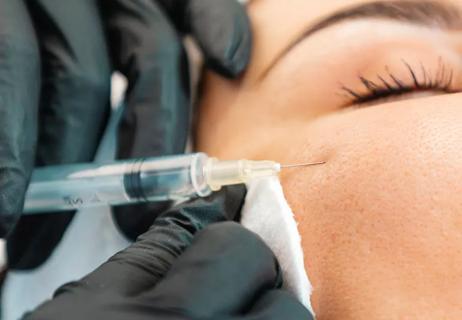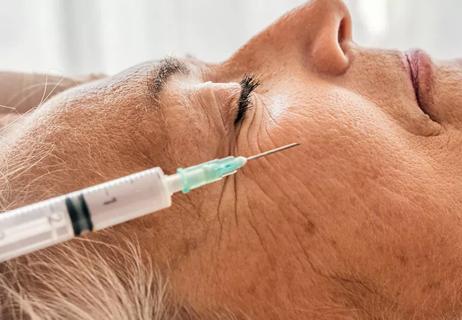This noninvasive procedure can help aging skin by boosting collagen production

You may have gotten an ultrasound during a pregnancy or an abdominal ultrasound to help pinpoint stomach pain.
Advertisement
Cleveland Clinic is a non-profit academic medical center. Advertising on our site helps support our mission. We do not endorse non-Cleveland Clinic products or services. Policy
But you might not realize that ultrasound imaging can also be used to lift skin and promote collagen production. And if you’ve been thinking about getting a facelift, an ultrasound facial may be an option.
Approved by the U.S. Food and Drug Administration (FDA), the noninvasive treatment uses a high-intensity focused ultrasound (HIFU) to target deep tissue layers, stimulating new collagen growth.
An ultrasound skin tightening device can be used to focus energy where it’s most needed: eyebrows, neck, under-chin area and even your decolletage (chest area). You’ll see a notable lift and tightening in your skin’s overall appearance.
So, is an ultrasound facial right for you?
Aesthetician Amanda Kanaan explains how an ultrasound facial works and the potential side effects.
An ultrasound skin tightening device typically reaches 5 millimeters deep under your skin, penetrating into the second layer of muscles underneath your facial muscles.
Need some perspective? Lasers don’t even go that deep, says Kanaan. And going deep into your skin matters because that’s where your skin makes new collagen.
“Unlike other laser treatments that simply target the outer layers of skin, ultrasound therapy bypasses the skin’s surface,” explains Kanaan. “It delivers collagen-stimulating ultrasound energy to the deepest layers.”
Advertisement
The in-office procedure may take anywhere from two to three hours, depending on the different areas you’re having treated.
An ultrasound facial can be used in these areas:
An ultrasound facial helps stimulate collagen. It may also include the following benefits:
The dermis layer of your skin contains most of your skin’s specialized cells and structures. It synthesizes less collagen each year after about the age of 20. Estrogen levels also decrease after menopause, leaving your skin drier, thinner and less taut than before.
“Once the dermis begins producing the new collagen, sagging facial and neck skin lifts and starts to look younger and tighter,” notes Kanaan.
Because ultrasound therapy is noninvasive, there’s no cutting, no stitches and no downtime.
An ultrasound facial is a good alternative for those who can’t or don’t want a facelift or who at least want to put off surgery for a few years. People with mild to moderate facial and neck skin that’s loose make good candidates for ultrasound therapy treatments.
Even people under age 30 can use the procedure as a preventive measure. Some plastic surgeons use the therapy on surgical facelift patients to enhance and prolong surgery results.
“After the procedure, clients can go right back to their normal activities without having to follow any special post-procedure instructions,” says Kanaan.
Most people see the full effect of the treatment about three to six months after the procedure. Some notice initial effects sooner. One treatment is usually sufficient. But some people need three or more sessions to achieve the desired goal.
It’s important to note that as an ultrasound facial is considered a cosmetic procedure, most insurance won’t cover the cost.
Is there anyone who should avoid getting an ultrasound facial? If you’re pregnant, breastfeeding or have an autoimmune disease like lupus or rheumatoid arthritis, you may not be a good candidate for this procedure and should speak with your healthcare provider.
While there’s essentially no downtime with an ultrasound facial, you may experience minimal bruising and tenderness. You may also see slight redness where your skin was treated for about an hour following the procedure.
These side effects are typically temporary. In some cases, skin tenderness may last for a month after treatment.
Advertisement
An ultrasound facial may be a good option if you’re noticing sagging skin and wrinkles. The noninvasive treatment essentially has no downtime and minimal side effects, so it may be good for those who don’t want or aren’t ready for a facelift.
Think you’re interested? Kanaan stresses the importance of doing your homework before deciding to try an ultrasound facial. That includes reading up on the treatment and coming up with questions to ask your healthcare provider to make sure you understand how it all works, what to expect and how much it may cost.
“Make certain the practitioner who does your procedure is certified and experienced in the treatment,” advises Kanaan.
Advertisement
Learn more about our editorial process.
Advertisement

Topical treatments — and even some cosmetic procedures — may help reduce the appearance of this crinkled-paper look

Though popular with influencers and celebrities, there’s little research to back up claims that they work

Your blood vessels shrink and your skin forms wrinkles to help you grip objects

Try limiting heat styling and eating a healthy diet instead

Lifestyle changes, neck exercises, injections and surgery can all help improve turkey neck

Using tape to smooth wrinkles may be a temporary fix, but there are still risks

A plastic surgeon explains your cosmetic injection options

What you can do for laugh lines and facial creases

The best parenting style balances enforcing rules and showing plenty of love

Tips include cutting back on sugar, focusing on exercise and managing stress

It can be harder to let go when you’ve invested time, energy and emotions — but it might be the healthier choice long term